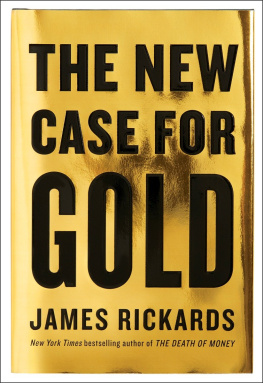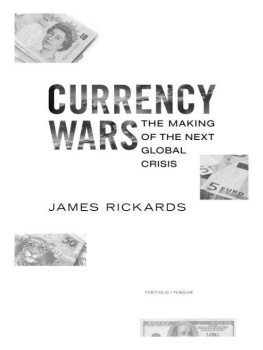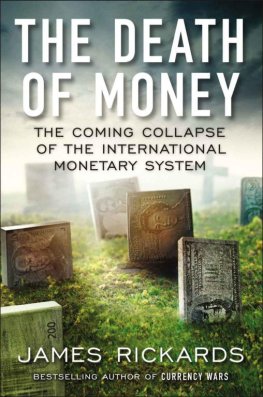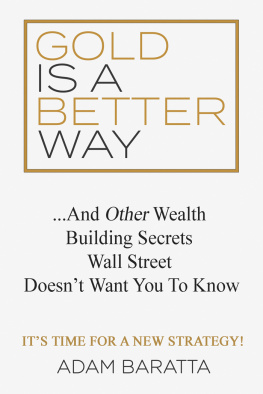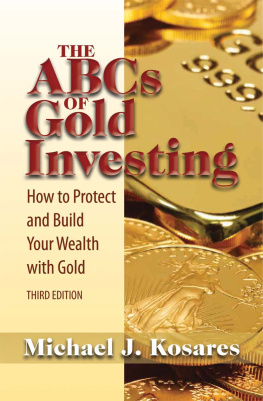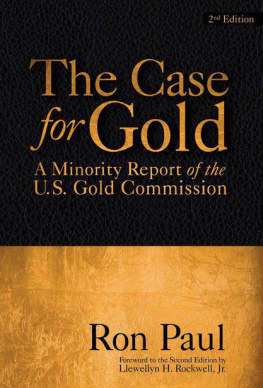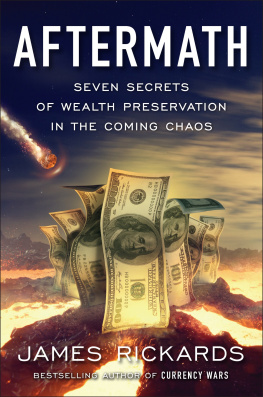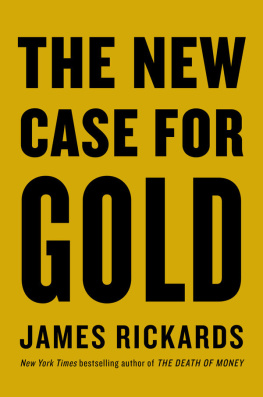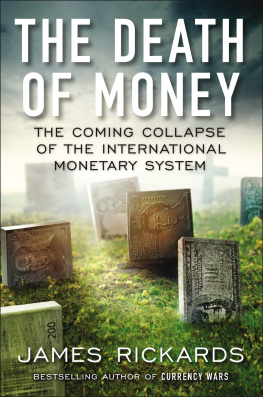Penguin supports copyright. Copyright fuels creativity, encourages diverse voices, promotes free speech, and creates a vibrant culture. Thank you for buying an authorized edition of this book and for complying with copyright laws by not reproducing, scanning, or distributing any part of it in any form without permission. You are supporting writers and allowing Penguin to continue to publish books for every reader.
This publication is designed to provide accurate and authoritative information in regard to the subject matter covered. It is sold with the understanding that the publisher is not engaged in rendering legal, accounting, or other professional services. If you require legal advice or other expert assistance, you should seek the services of a competent professional.
To my mother, Sally Rickards, who taught me something more valuable than goldlove
The twelve gates were twelve pearls, each of the gates made from a single pearl; and the street of the city was of pure gold, transparent as glass.
INTRODUCTION
G old is a barbarous relic. How many times have you heard this saying before? If, like me, you write and speak publicly about gold, you have heard it a thousand times. It is part of a well-rehearsed litany of those with complete confidence in paper money, and no confidence in gold. As soon as anyone utters a kind word for gold, out comes this robo-response of the good and great fans of fiat.
The antigold reflex is intergenerational. Among the older generation are PhDs who came of age in the wake of famous gold bashers such as Milton Friedman. This generation includes Paul Krugman, Barry Eichengreen, Nouriel Roubini, Martin Feldstein, and others who cover the ideological spectrum from left to right. Friedmans other theoretical contributions are mostly obsolete (it turns out that floating exchange rates are suboptimal, and money velocity is not stable), yet that has done nothing to tarnish how his acolytes perceive gold.
These antigold giants are now joined by a younger generation educated (or miseducated) to believe that gold has no place in a monetary system. This group includes prominent bloggers and commentators such as Barry Ritholtz, Matt OBrien, Dagen McDowell, and Joe Weisenthal. The antigold crowd does not care if you wear gold rings or watches, although they look at you with condescension leavened with pity when you reveal that you actually own gold bullion. Still, they show their fangs at the mere mention of a gold standard. Thats beyond the pale. They are ready, like a carbine with a hair trigger, to fire off arguments on why a gold standard cannot work, will not work, and has always failed. Epithets like antediluvian and Neanderthal are thrown in for good measure.
This book, The New Case for Gold, makes the argument that gold is money, that monetary standards based on gold are possible, even desirable, and that in the absence of an official gold standard, individuals should go on a personal gold standard, by buying gold, to preserve wealth.
As I set out to make the case for gold, its comforting to know Im not alone. Along with the new generation of gold critics comes a new generation of smart, thoughtful gold advocates. These young guns of gold include Ronni Stoeferle and Mark Valek in Vienna; Jordan Elieso and Janie Simpson in Sydney; Jan Skoyles in London; Koos Jansen (real name: Jan Nieuwenhuijs) in The Netherlands; and Elaine Diane Taylor in Vancouver. Its quite a network! They are a constant source of encouragement and fresh insights for me.
Yet, before we make the case for gold, it would be salutary to demolish the case against gold first. The next time a gold basher resorts to a reflex response, you will know how to stop him in his tracks with facts, not clichs.
What is the case against gold? The critics know it by heart. Heres the bill of particulars:
1. Gold is a barbarous relic, according to John Maynard Keynes.
2. There is not enough gold to support finance and commerce.
3. Gold supply does not grow fast enough to support world growth.
4. Gold caused the Great Depression.
5. Gold has no yield.
6. Gold has no intrinsic value.
Each of these assertions is obsolete, false, or ironically an argument in favor of gold. That does not stop the fiat money ideologues from asserting them. Lets dissect these one at a time.
Gold Is a Barbarous Relic, According to John Maynard Keynes
This is an easy one to rebut. Keynes never said it.
What he did say was more interesting. In his book Monetary Reform (1924), Keynes wrote, In truth, the gold standard is already a barbarous relic. Keynes was not discussing gold but rather a gold standard, and in the 1924 context he was right. The notoriously flawed gold exchange standard that prevailed in various forms from 1922 to 1939 should never have been adopted, and should have been abandoned long before it died with the outbreak of the Second World War.
Keynes was above all a pragmatist. In July 1914, at the start of the First World War, Keynes was the most persuasive voice for remaining on the classical gold standard that had prevailed since 1870. Most countries entering the war abandoned the gold standard immediately in order to finance the war with the gold they retained. His Majestys Treasury and the Bank of England wanted to do the same.
Keynes argued, in effect, that gold as money was finite, yet credit was elastic. By remaining on the gold standard, and upholding Londons role as the center of global finance, the United Kingdoms credit would be enhanced. London could borrow the money needed to finance the war.
That is exactly what happened. The House of Morgan in New York organized massive loans for the United Kingdom and none for Germany or Austria. This finance was critical to Britains ability to hold out until the United States entered the war in 1917. Victory came the following year.
In 1925, as chancellor of the exchequer, Winston Churchill contemplated returning the United Kingdom to the gold standard at the prewar parity. Keynes told Churchill this would be a deflationary disaster. Keynes did not support the gold standard. Still, he insisted that if Britain was going to have one, it was crucial to get the price right. Keynes recommended a much higher price for gold. Churchill ignored Keyness advice. The result was massive deflation and depression in Great Britain, years before depression struck the rest of the world.
In July 1944, near the end of his life, Keynes argued at Bretton Woods for a new form of world money he called the bancor, the theoretical predecessor to todays special drawing right (SDR). The bancor would be backed by a commodity basket including gold. It was not a strict gold standard. Still, it did give gold an important place in the monetary system. Keyness plan was pushed aside in favor of a dollar-gold standard championed by the United States, which lasted from 1944 to 1971.
In short, Keynes was an advocate for gold early in his career, an astute adviser on gold in mid-career, and an advocate for gold again late in his career. In between, he properly disparaged the operation of a flawed gold exchange standard. Keep Keyness nuanced view of gold in mind the next time someone throws the phrase barbarous relic at you.

